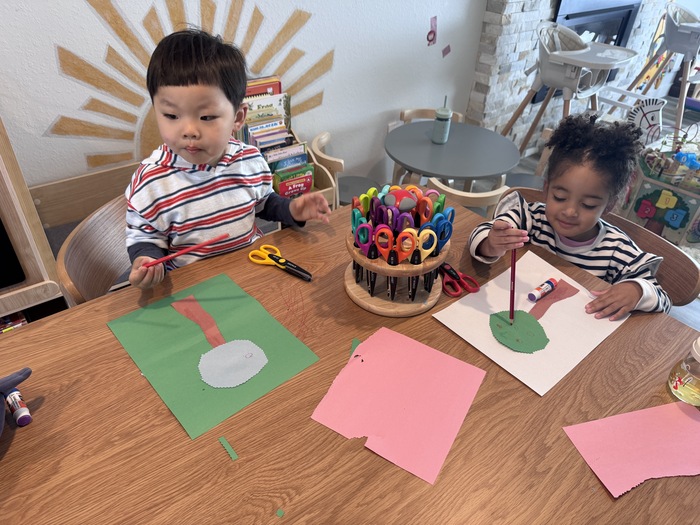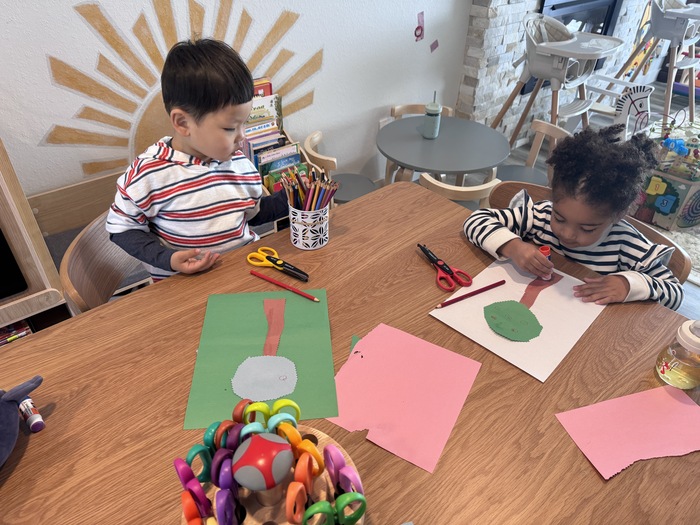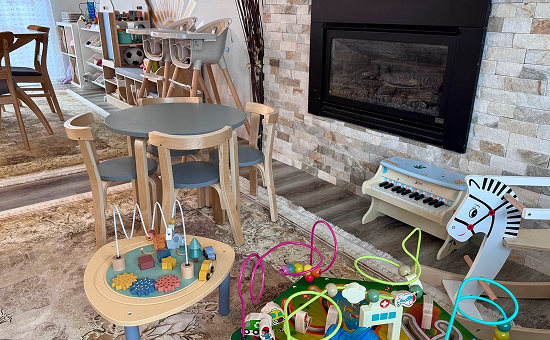Craft activities are more than just fun—they’re a cornerstone of early childhood development. In daycare, childcare, and home daycare settings, crafts provide children with opportunities to explore their creativity, build essential skills, and prepare for future learning. From painting and gluing to cutting and sculpting, these hands-on activities engage young minds in meaningful ways. Whether it’s an infant exploring textures or a preschooler creating a masterpiece, crafts foster growth in cognitive, physical, and social-emotional domains. This article explores the numerous benefits of crafts for kids, offering insights for parents and caregivers on why incorporating creative activities into daycare and childcare routines is essential. With a focus on early childhood education, we’ll uncover how crafts support development and provide practical tips for integrating them into daily routines.
Why Crafts Matter in Early Childhood
Crafts are a powerful tool in early childhood education, particularly in daycare and home daycare environments. They encourage children to think creatively, solve problems, and express themselves. Unlike structured academic tasks, crafts allow kids to explore without fear of failure, fostering a love for learning. In childcare settings, crafts align with developmental milestones, supporting infants, toddlers, and preschoolers in unique ways. For example, infants benefit from sensory exploration, while preschoolers develop critical thinking through complex projects. Crafts also promote independence, as children make choices about colors, materials, and designs. By integrating arts and crafts into daily routines, daycare providers create enriching experiences that lay the foundation for lifelong skills.
Cognitive Benefits of Crafts for Kids
Crafts stimulate cognitive development by engaging children’s brains in problem-solving and critical thinking. When kids plan a project, they practice decision-making, such as choosing materials or sequencing steps. For instance, creating a collage requires sorting, categorizing, and spatial reasoning—skills essential for math and science. In daycare settings, crafts encourage focus and concentration, as children immerse themselves in tasks like cutting shapes or threading beads. These activities also enhance memory, as kids follow instructions or recall patterns. For infants in childcare, simple crafts like finger painting introduce cause-and-effect relationships, such as how colors mix. By fostering curiosity and experimentation, crafts prepare children for academic success while making learning enjoyable.

Physical Development Through Craft Activities
Craft activities are excellent for developing fine motor skills, which are critical for tasks like writing and self-care. In daycare and home daycare, activities like cutting, gluing, and drawing strengthen hand muscles and improve hand-eye coordination. For infants, sensory crafts like exploring soft fabrics or squishing playdough enhance tactile awareness. Toddlers benefit from activities like stringing beads, which refine dexterity. Preschoolers, meanwhile, tackle more complex tasks like folding paper or using safety scissors, building precision and control. These physical skills translate to everyday activities, such as buttoning clothes or holding a pencil. By incorporating crafts into childcare routines, caregivers support physical development in a fun, engaging way.
Social and Emotional Growth
Crafts in daycare and childcare settings foster social-emotional development by encouraging collaboration and self-expression. Group projects, like creating a mural, teach kids to share materials, communicate ideas, and work as a team. These experiences build empathy and cooperation, essential for social interactions. Individually, crafts allow children to express emotions through colors, shapes, and designs, helping them process feelings in a safe way. For example, a child might draw a picture to express joy or frustration, building emotional resilience. In home daycare, where smaller groups create a nurturing environment, crafts provide opportunities for personalized attention, boosting confidence. By celebrating each child’s unique creations, caregivers reinforce self-esteem and a sense of accomplishment.
Crafts in Daycare and Childcare Settings
Daycare and home daycare programs are ideal for incorporating crafts, as they provide structured yet flexible environments for creative exploration. Crafts can be tailored to suit different age groups, from infants to preschoolers. For example, infant care might include sensory bins with safe, textured materials, while preschoolers engage in themed projects like holiday decorations. Caregivers can integrate crafts into daily schedules, using them to reinforce lessons or themes, such as animals or seasons. Crafts also support transitions, helping children stay engaged during downtime. By creating a craft-friendly environment, daycare providers enhance learning while fostering a sense of community. Parents can look for programs that prioritize hands-on activities to ensure their child’s development is well-rounded.

Age-Appropriate Craft Ideas for Kids
- Toddlers (2–3 years) in Childcare: Simple projects like paper plate animals or gluing tissue paper onto clear plastic cups to create “stained glass” decorations encourage creativity and fine motor skills. These activities are engaging and manageable in childcare settings, promoting independence. [Internal Link: engaging childcare activities]
- Preschoolers (3–5 years) in Daycare: More complex crafts, such as creating paper mosaics or building simple birdhouses from craft sticks, challenge preschoolers to follow multi-step instructions. These projects foster problem-solving and patience while allowing kids to take pride in their creations.
- Mixed-Age Groups in Home Daycare: Collaborative crafts, like a group collage or a seasonal wreath, work well in home daycare settings. These activities encourage teamwork and communication, making them ideal for small, family-like environments.
When planning crafts, caregivers should use safe, non-toxic materials and supervise closely, especially for younger children. Incorporating themes tied to learning goals, such as shapes or colors, enhances educational value. These activities not only entertain but also lay the groundwork for skills children will use in school and beyond.
Tips for Parents and Caregivers
Parents and caregivers can maximize the benefits of crafts by creating a supportive environment. Here are practical tips for integrating crafts into daycare, childcare, or home daycare:
- Set Up a Craft Station: Dedicate a space with accessible supplies like paper, glue, crayons, and scissors (age-appropriate). Keep it organized to encourage independence.
- Choose Simple Materials: Use everyday items like cardboard tubes, cotton balls, or recycled materials to keep costs low and spark creativity.
- Encourage Exploration: Let children experiment without rigid expectations. Allow them to choose colors or designs to foster decision-making.
- Incorporate Learning: Tie crafts to educational themes, like creating letter-shaped collages to reinforce alphabet recognition.
- Celebrate Effort: Praise the process, not just the result, to build confidence. Display creations to show children their work is valued.
- Ensure Safety: Use non-toxic materials and supervise closely, especially for infants and toddlers in childcare settings.
- Make It Routine: Schedule regular craft time in daycare or home daycare to build consistency and excitement.
By fostering a creative environment, caregivers help children develop skills that extend beyond the craft table, preparing them for academic and social success.
Conclusion: Why Kidoheaven Prioritizes Crafts
At Kidoheaven, we believe crafts are more than just activities—they’re a gateway to unlocking a child’s potential. Our daycare in Bothell and our home daycare in Bothell programs prioritize hands-on creative projects to nurture cognitive, physical, and social-emotional growth. From infants exploring sensory crafts to preschoolers tackling complex projects, our caregivers design activities that spark joy and build essential skills. By fostering creativity in a safe, supportive environment, we help children develop confidence, problem-solving abilities, and a love for learning. Whether it’s through painting, sculpting, or collaborative projects, Kidoheaven ensures every child has opportunities to grow through play. Visit kidoheaven.com to learn how our childcare programs incorporate crafts to support your child’s development.
📣 Call to Action: Your Child’s Growth and Safety Are Our Priority
At Kido Heaven Child Care, we understand that choosing the right daycare or childcare provider is a significant decision for parents. That’s why we create a nurturing, creative, and safe environment where your child can thrive. Our programs incorporate engaging crafts and activities tailored to support infant care, toddler development, and preschool learning, all while adhering to the highest safety standards. Visit kidoheaven.com to discover how we prioritize your child’s growth, creativity, and well-being in our daycare and home daycare settings.
Want to learn more or schedule a tour?
📞 Call us at 206-734-2040
🌐 Visit: www.kidoheaven.com
📍 We are a licensed family home daycare in Bothell, WA
We welcome you to join our growing family, where your child’s safety and development come first.
Follow Our Mealtime Moments
Stay updated with more beautiful outdoor meals and daily learning routines on:
Instagram | Facebook | Nextdoor | Yelp | Winnie | YouTube | Upwards
FAQ
1. Why are crafts important for kids in daycare?
Crafts promote cognitive, physical, and social-emotional development. They enhance fine motor skills, encourage creativity, and foster collaboration, making them essential for early childhood education in daycare settings.
2. What types of crafts are safe for infants in childcare?
Sensory-based crafts, like finger painting with edible paints or exploring textured materials, are safe and beneficial for infants. Always ensure materials are non-toxic and supervise closely.
3. How can parents encourage creativity at home?
Provide a variety of supplies, allow freedom in projects, and celebrate effort. Simple crafts like paper collages or playdough sculptures spark creativity in home daycare settings.
4. How do crafts support school readiness?
Crafts build skills like problem-solving, fine motor control, and focus, which are critical for writing, math, and classroom collaboration. They also encourage perseverance and confidence.
5. Can crafts be part of a daycare curriculum?
Yes, crafts can be integrated into daily schedules to reinforce learning themes, support transitions, and create a fun, engaging environment in daycare and childcare programs.



